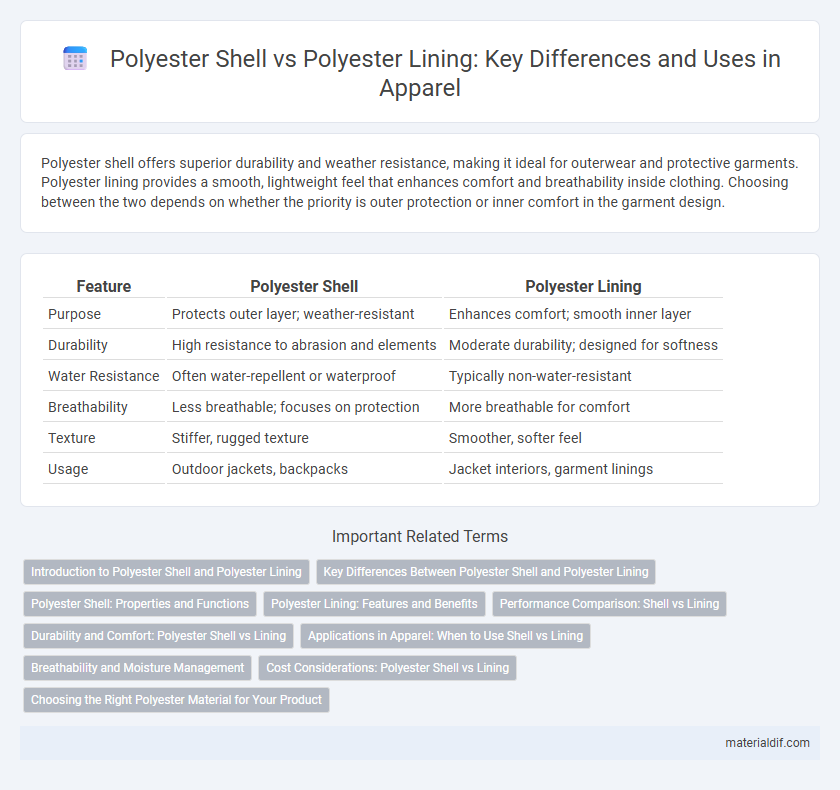Polyester shell offers superior durability and weather resistance, making it ideal for outerwear and protective garments. Polyester lining provides a smooth, lightweight feel that enhances comfort and breathability inside clothing. Choosing between the two depends on whether the priority is outer protection or inner comfort in the garment design.
Table of Comparison
| Feature | Polyester Shell | Polyester Lining |
|---|---|---|
| Purpose | Protects outer layer; weather-resistant | Enhances comfort; smooth inner layer |
| Durability | High resistance to abrasion and elements | Moderate durability; designed for softness |
| Water Resistance | Often water-repellent or waterproof | Typically non-water-resistant |
| Breathability | Less breathable; focuses on protection | More breathable for comfort |
| Texture | Stiffer, rugged texture | Smoother, softer feel |
| Usage | Outdoor jackets, backpacks | Jacket interiors, garment linings |
Introduction to Polyester Shell and Polyester Lining
Polyester shell is a durable outer fabric commonly used in apparel and outerwear for its water resistance and windproof properties. Polyester lining, on the other hand, serves as an inner layer providing comfort, moisture wicking, and smoothness against the skin. Both materials leverage polyester's strength and lightweight nature but serve distinct functional roles in garment construction.
Key Differences Between Polyester Shell and Polyester Lining
Polyester shell fabric is designed for durability, water resistance, and wind protection, making it ideal for outerwear and jackets, while polyester lining focuses on providing comfort, breathability, and smoothness against the skin. Shell polyester is usually thicker and more rigid to shield against environmental elements, whereas polyester lining is thinner, lightweight, and often has a satin finish to facilitate easy garment movement. The key difference lies in their functional roles: shell polyester delivers structural support and weather defense, whereas polyester lining ensures comfort and moisture management inside the garment.
Polyester Shell: Properties and Functions
Polyester shell fabric is highly durable, water-resistant, and windproof, making it ideal for outerwear and protective clothing. Its lightweight and breathable properties provide comfort while maintaining structural integrity against environmental elements. The polyester shell also offers excellent color retention and resistance to wrinkles, enhancing garment longevity and appearance.
Polyester Lining: Features and Benefits
Polyester lining offers smooth texture and excellent breathability, enhancing garment comfort and wearability. Its moisture-wicking properties help regulate body temperature, making it ideal for activewear and outerwear. Durable and wrinkle-resistant, polyester lining ensures garments maintain their shape and appearance over time.
Performance Comparison: Shell vs Lining
Polyester shell fabric offers higher durability and better resistance to wind and abrasion compared to polyester lining, making it ideal for outerwear exposed to harsh conditions. The polyester lining is designed for comfort, breathability, and smoothness, enhancing garment wearability without compromising moisture-wicking properties. Performance differences hinge on the shell's structural toughness versus the lining's focus on softness and moisture management within clothing layers.
Durability and Comfort: Polyester Shell vs Lining
Polyester shells offer high durability, resistance to abrasion, and excellent weather protection, making them ideal for outerwear exposed to harsh conditions. In contrast, polyester linings prioritize comfort with their smooth, lightweight, and breathable properties, enhancing wearability and moisture-wicking inside garments. Both components balance durability and comfort, but shells are engineered for toughness, while linings focus on softness and heat regulation.
Applications in Apparel: When to Use Shell vs Lining
Polyester shell fabric offers durability, water resistance, and windproof qualities ideal for outerwear like jackets and coats, where protection from elements is essential. Polyester lining, on the other hand, provides smoothness, breathability, and comfort inside garments such as suits, dresses, and insulated clothing, enhancing wearability without adding bulk. Choosing polyester shell versus lining depends on the garment's function; use shell for external protection and durability, and lining for interior comfort and ease of movement.
Breathability and Moisture Management
Polyester shell fabrics typically offer higher durability and water resistance but have lower breathability compared to polyester linings, which are engineered to enhance moisture wicking and ventilation. Polyester linings efficiently pull sweat away from the body, promoting quicker evaporation and improved moisture management during physical activities. Selecting the right combination of polyester shell and lining materials can optimize both breathability and moisture control for activewear and outdoor gear.
Cost Considerations: Polyester Shell vs Lining
Polyester shell fabrics typically incur higher production costs due to denser weaves and enhanced durability needed for outerwear applications, whereas polyester linings are generally lighter and less expensive, optimized for comfort and ease of movement. The cost difference is influenced by factors such as fiber thickness, finishing treatments, and fabric weight, with shells often requiring weather-resistant coatings that increase expenses. Budget-conscious manufacturers often balance these costs by selecting more economical polyester lining materials while investing in premium polyester shells for performance and longevity.
Choosing the Right Polyester Material for Your Product
Polyester shell fabric offers durability and water resistance, making it ideal for outerwear and protective gear, while polyester lining provides smoothness and breathability, enhancing comfort in garments. Selecting the right polyester material depends on the product's functional requirements; shells require sturdiness and weather resistance, whereas linings prioritize softness and moisture-wicking properties. Understanding the specific application of your product ensures optimal performance by leveraging the distinct characteristics of polyester shell and lining fabrics.
Polyester Shell vs Polyester Lining Infographic

 materialdif.com
materialdif.com